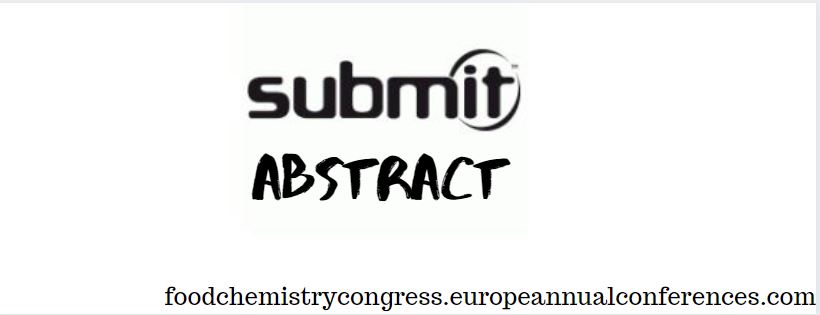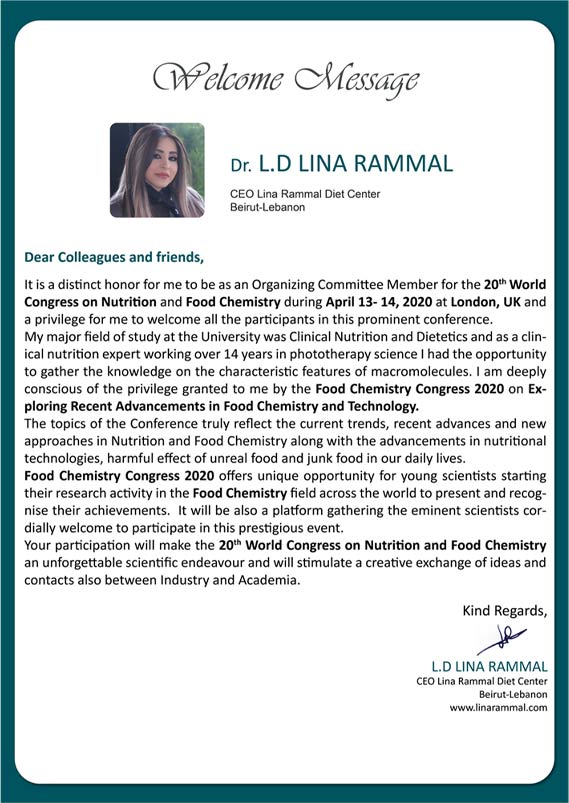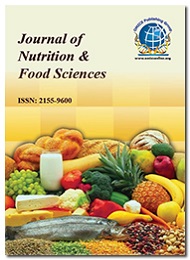Theme: Exploring Recent Advancements In Food Chemistry And Technology
Food Chemistry Congress 2020
Food Chemistry Congress 2020 cordially welcomes all the participants and contributors from worldwide to attend 20th World Congress on Nutrition and Food Chemistry which is going to be held in London, UK during April 13-14 2020 across the theme “Exploring Recent Advancements in Food Chemistry and Technology”.
We invite you to join us at Food Chemistry Congress 2020, where you will be sure to have a meaningful experience with scholars from around the world. Generous response and active participation from the Editorial Board Members of conference related Journals as well as from the scientists, researchers and leaders in the field of Food Chemistry will make this conference as one of the most successful and productive events in 2020.
Food Chemistry deals with the chemical aspects of human food and animal feed. It covers the chemical make-up of food, interactions between different foods and ingredients, or foods and the materials used to process and store them. Much of the focus is on the proteins, lipids, and carbohydrates that are contained in foodstuffs, but vitamins, secondary metabolites, minerals, and many other constituents are also of interest. Likewise, interest can be focused on impurities in foods, either from decomposition or introduced at some point in the procedures for food production, harvesting, processing, storage, or distribution. Food chemistry should be applied in the analysis of dietary content to monitor or improve nutrition, or the determination of levels of contaminants to ensure food safety. Chemical food analysis can also be used to compare food products that utilize different ingredients, or that are subjected to different processing methods.
Food Chemistry conference Committee extends its welcome to 20th World Congress on Nutrition and Food Chemistry during April 13-14, 2019 London, UK and with this activity we focus on “Exploring Recent Advancements In Food Chemistry And Technology ” in our daily lives. Participating at Food Chemistry Congress 2020 will provide you an amazing chance to communicate with world-class Nutrition Specialists, Food chemists , Dieticians, Clinical Nutritionists experts and making a channel for collaborations then partnerships. Food Chemistry 2020 includes prompt Keynote presentations, Oral talks (Speaker forum and Young research forum), Poster presentations, Workshops, Symposium and Exhibitions.
Food chemistry is the study of chemical process and interaction of all biological and non- biological components of food. The biological substances include such items as meat, poultry, lettuce, beer, and milk as examples. It covers with organic chemistry in that it manages the parts of nourishment, for example, sugars, lipids, proteins, water, vitamins, and dietary minerals. Furthermore, it includes the investigation and improvement of nutrients and preservatives added substances that can be utilized to safeguard the nature of sustenance or to alter its shading, flavor, and taste. Food chemistry plays a major role in ensuring that the food being processed is of high quality and safe for consumption. Understanding food chemistry helps us develop proper ways of handling food and also develop good manufacturing practices.
- Energy Metabolism of Starch
- Food in Water, Food Proteins, Vitamins and Minerals
- Chemical Changes During Food Process
- Metabolism of Food Components
- Economy of World Food Marketing and Agri-business: Report, Global Issues and Challenges
- New trends in Food Science & Technology
- Food Biochemistry
Track 2: FOOD ANALYSIS AND QUALITY CONTROL
Food analysis is the control managing the advancement, application and investigation of explanatory strategies for describing the properties of nourishment and their constituents. These diagnostic techniques are utilized to give data about a wide range of attributes of nourishment's.
Quality control, or QC for short, is a procedure by which substances survey the nature of all elements engaged with creation. ISO 9000 characterizes quality control as "A piece of value administration concentrated on satisfying quality prerequisites.
This methodology puts an accentuation on three perspectives (revered in guidelines, for example, ISO 9001). Quality control involves the examination of a product, service, or process for certain minimum levels of quality. The goal of a quality control team is to identify products or services that do not meet a company’s specified standards of quality Review is a noteworthy part of value control, where physical item is inspected outwardly (or the final products of an administration are dissected). Item assessors will be given records and depictions of inadmissible item imperfections, for example, breaks or surface flaws for instance.
- Analysis of Protein, Fats and Carbohydrates in Foods
- Food Grading
- Nutritional Value
- Analytical Techniques In Food Analysis
- Physical, Chemical and Biological Hazards and Treatment
- HACCP
- Critical Control Point
A drug interaction is a situation in which a substance affects the activity of a drug, i.e. the effects are increased or decreased, or they produce a new effect that neither produces on its own. These interactions may occur out of accidental misuse or due to lack of knowledge about the active ingredients involved in the relevant substances. A drug interaction is notices to the substance which influences the action of a medication, i.e. the knocks are at its peak or at its down too or they create another smash that neither controlled by own. Associations among nourishment and medications may accidentally tapering off or adjunct the medication impact.
- Food that interacts with Drug
- Uses of Drug Related to Diseases
- Effect of Drugs to the Body according to their amount
- Food and Drug Metabolism
- Food and Drug Administration
Track 4: FOOD ADDITIVES
Food additives are substances added to food to maintain or improve its safety, freshness, taste, texture, or appearance. A few added substances have been utilized for a limited length of time; for instance, protecting sustenance by pickling (with vinegar), salting, likewise with bacon, safeguarding desserts or utilizing sulfur dioxide similarly as with beverages. The use of food additives is only justified when their use has a technological need, does not mislead consumers, and serves a well-defined technological function, such as to preserve the nutritional quality of the food or enhance the stability of the food. Flavouring agents are also added to food items just to enhance the taste and the flavour of them. Adding flavour to them also demands some limits i.e, they should be added as per conditions given officially. This numbering plan has now been received and stretched out by the many researchers and organizations to universally distinguish all added substances, paying little heed to whether they are endorsed for utilize.
- Food additives and their appearance
- Food additives and technology
- Flavouring agents
- Food additives and processed food
- Food Additives and Ingredients Association
Track 5: FOOD NUTRITION AND HEALTH
The effective management of food intake and nutrition are both key to good health. There are six categories of nutrients that the body needs to acquire from food: protein, carbohydrates, fat, fiber, vitamins, minerals and water. It includes food intake, absorption, assimilation, biosynthesis, catabolism and excretion. The diet of an organism is what it eats, which is largely determined by the availability, processing and palatability of foods. A healthy diet includes preparation of food and storage methods that preserve nutrients from oxidation, heat or leaching, and that reduce risk of food-borne illnesses. A poor diet may have an injurious impact on health, causing deficiency diseases such as blindness, anemia, scurvy, preterm birth, stillbirth and cretinism; health-threatening conditions like obesity and metabolic syndrome; and such common chronic systemic diseases as cardiovascular disease, diabetes, and osteoporosis.
- Food and storage methods
- Deficiency diseases
- Chronic systemic disease
- Food nutrition and good health
Bioactive are the nonessential biomolecules that are present in foods and exhibit the capacity to modulate one or more metabolic processes, which results in the promotion of better health. Aside from supplements, nourishment contains little measures of purported bioactive mixes. These mixes include an incentive past nourishment, specifically influencing physiological capacities in our body by following up on cell pathways. Epidemiologic examinations, where the impacts of an eating routine in various populaces are watched, show that the individuals who eat natural products, vegetables, entire grains and fish are probably going to lead a long and solid life. We know almost no of which intensifies that create wellbeing impacts and the instruments included.
- Bioactive mixes
- Food bio-actives and pathways
- Physiological activities
Track 7: FOOD PROCESSING & PRESERVATION
Food preservation is preventing the growth of micro-organisms as well as retarding the oxidation of fats that cause rancidity thus encouraging longer shelf life and reduced hazard from eating the food. Safety is a major concern in food processing, because packaged food can be contaminated easily and due to increase in contamination it can quickly cause widespread illness. Food processing must be balanced with food preservation also. Some preservation methods cause diseases to the human like addition of food additives for preservation. Nowadays many methods and techniques are used in food processing, packaging to improve the quality and shelf life of foods and to create the barrier from oxygen, light, UV etc. The tale ingredients and food design are used to alternate the food items to improve the Rheology, characteristics, shelf life of foods.
- Food Preservation and Food Processing
- Improvement of quality and shelf life
- Improving packaged food
Food packaging provides protection, tampering resistance, and special physical, chemical, or biological needs. Traceability, convenience, and tamper indication are secondary functions of increasing importance. It may bear a nutrition facts label and other information about food being offered for sale. It is the vital component of food industry, as it prolongs food storage and enables long distance transportation, as well as appealing to consumer. A choice of packaging machinery requires rumination of technical capabilities, labour requirements, worker safety, maintainability, serviceability, reliability, ability to integrate into the packaging line, capital cost, floorspace, flexibility (different for different matters), energy usage, quality of outgoing packages, qualifications (for food, pharmaceuticals, etc.), throughput, efficiency, productivity, and ergonomics, at a minimum.
- Food packaging and protection
- Food industries
- Food storage and food technology
- Food nutrition
National legal frameworks are a key pillar in an effective food control system. Least quality necessities are incorporated into the nourishment law to guarantee the sustenance delivered are unadulterated and are not subjected to any false practices expected to cheat the customer. Sustenance law should cover the aggregate chain starting with arrangements for creature sustain, on-cultivate controls and early handling through to definite conveyance and use by the shopper. Is a logical teaching depicting dealing with, planning, and capacity of sustenance in ways that causes foodborne disease. This includes various schedules that has to be taken after to stay away from potential wellbeing risks. Along these lines nourishment security frequently covers with sustenance guard to avoid misdemeanour to customers. The tracks inside this line of thought are wellbeing amongst industry and the market and after that between the market and the purchaser.
- Food safety and laws
- Quality assurance
- Wellbeing between industry and market
Food nanotechnology is a zone of rising attention and opens up an entire universe of new conceivable outcomes for the sustenance business. Nanotechnology contains the manipulation of microscopic matter that ranges from 1 to 100 nm in size. Because food and water are obviously made up of particles that are on the nanometer scale, engineered nanoparticles are able to enter these products easily based on their similar properties. These particles can act as an entire unit by performing similar transportation functions that prove useful in almost every industry, particularly involving food products.
- Organized Nano sized additives
- Nano coating
- Nano sized chemicals
- Nano encapsulation
Track 11: DIET IN OBESITY AND UNDERWEIGHT
Obesity is a growing concern because being overweight is widely stared as a major risk factor for metabolic syndrome, cardiovascular disease, and early death. Although the mechanisms for this weight improvement have not been entirely elucidated, dietary factors may be important in the development of obesity. Diet contains of combinations of foods, and these individual components may have interactive or synergistic effects that make studying dietary factors in isolation difficult. Dietary patterns that signify a combination of foods may be more strongly related with disease risk than an individual food and nutrient. Previous studies have stated that dietary patterns that are high in fruits, vegetables, and fibre might be associated with a reduced risk of obesity.
- Diet, Exercise, Behavior and Lifestyle Interventions
- Anti-Aging
- Obesity and its Treatment
- Weight Management Tips
- Behaviour Modification
Track 12: CHEMICAL COMPOSITION OF FOOD
Food chemistry is the science which deals with the chemical composition and properties of food and the chemical changes it endures due to natural and artificial processing mechanism. Food composition data (FCD) are detailed sets of information on the nutritionally imperative components of food and offers high value for energy and nutrients with protein, carbohydrates, fat, vitamins and minerals and for significant food components such as fiber. The data are offered in food composition databases (FCDBs). Knowledge about the chemical composition of food is the first important parameter in dietary treatment of illness or in any quantitative study of human nutrition.
- Milk and Dairy Products
- Fruits and Vegetables
- Meat, Fish and Poultry Products
Track 13: FOOD INDUSTRY AND HEALTH HAZARDS
The Food Industry is the intricate system of agriculturists and assorted organizations that together supply a great part of the sustenance devoured by the total population. The nourishment business today has turned out to be profoundly broadened, with assembling going from little, conventional, family-run exercises that are exceptionally work serious, to vast, capital-escalated and very motorized modern procedures. Indeed, even with innovative advances and new controls, laborers in the nourishment handling and assembling industry keep on facing various wellbeing dangers. Food service operations have accident and illness rates as high as industries that are commonly thought of as being hazardous places to work.
- Chemical Hazards
- Machinery-Related Hazards
- Biological Hazards
- Physical/Extraneous Material Hazards
- Allergenic Hazards
- Effect of food on drug
Track 14: FOOD AND MENTAL HEALTH
The link between food and mental health is a healthy and nutritional diet.The dietician helped participants make adjustmentsto their diets, such as eating less junk food and more nutrient-rich foods such as produce, fish and legumes. People are now realizing there is not only a psychological connection but a biochemical and physical connection between what we eat, the way it makes us feel and our mental health.If we think about common illnesses like diabetes, cancer, high blood pressure and heart disease, there’s talk about how nutrition directly impacts these diseases and how you can reduce your risk by eating certain foods, following certain diet patterns and the same can be said about mental health.
Track 15: ENVIRONMENTAL IMPACT ON FOOD PRODUCTION & CONSUMPTION
Food production grant, for example, to climate change, natural disasters, depletion and damage of biodiversity. It is also a great loss of nature as well as food on other resources, such as nutrients, land area, energy, and water. In many countries environment disbalance leads to the weakening of natural resources due to attribution of human activities which impact agriculture directly. Farming techniques have evolved, and the use of fertilizers has decreased considerably during the last few decades. The global government, reserachers, scientists and universities are finding new solutions for improving production techniques, maximizing the effects of recycling, reusing by-products, and minimizing waste in order to reduce the nutrient loading attributable to production. The aim of the government is to find ways of mitigating the environmental and climatic impacts on food production.
- Food technology and environment
- Climatic and environmental impacts on food production
- Advancements in farming technology
- Improving production techniques
Track 16: AUTHENTICITY AND INTEGRITY OF FOOD
Food Integrity is the state of being whole, entire, or undiminished or in perfect condition. The originality and wholeness in food is the main key to be healthy. Provides assurance to consumers and other associate about safety, authenticity and quality of food. Food fraud is a major concern not only for consumers but for distributers and producers also. Unfortunately recurring food contamination scandals show that there is always room for error, whether intentional, adulterated, or fraudulent.
- Food Safety
- Consumer Regulation
- Food Commodity
- Food Traceability
Track 17: JUNK FOOD AND DIABETES
Nourished food is one of the simplest and most effective ways to prevent or manage the symptoms of diabetes. However, by making smart decisions, it is workable for those with diabetes to enjoy their favorite junk foods from time to time.Junk foods contribute to diabetes in these ways:
- Rapid effect on blood sugar levels
- Triglyceride levels
Track 18: IMPORTANCE OF FOOD NUTRITON
Good nutrition is an important part of leading a healthy lifestyle. Combined with physical activity, your diet can help you to reach and maintain a healthy weight, reduce your risk of nutritional disease and chronic diseases (like heart disease and cancer), and promote your overall health. Nutritional diet helps in reducing weight gain at every age.
- Nutritional Deficiencies
- Weight gain
- High blood pressure
Food microbiology is the scientific study of microorganisms that is used both in food and for the food production. This includes microorganisms those spoils food, as well as those which are used in food production; for example production of alcohols, production of juices, production of yoghurt and cheese etc. This is the study of microorganisms that inhibit, create, or contaminate food. Some of the microorganisms causing food spoilage, pathogens caused contamination in food as they are improperly cooked or they stored in unhygienic manner. Some of the microbes (Acetobacter aceti, Lactobacillus acedophillus etc) are useful as they help us in production of alcohols, breads, dairy products, and in manufacturing of probiotics.
Foodborne illness or foodborne disease or food poisoning is any illness resulting from the food spoilage of contaminated food, pathogenic bacteria, viruses, or parasites that contaminate food. Foodborne illnesses are infections or irascibilities of the gastrointestinal (GI) tract triggered by food or beverages that contain harmful bacteria, parasites, viruses, or chemicals. The GI tract is a sequence of hollow organs joined in a long, twisting tube from the mouth to the anus. Common symptoms of foodborne illnesses are vomiting, diarrhoea, abdominal pain, fever, and chills.
Enzymes are the catalysts which perform specific reactions essential for the production and improve the quality of the final product. Very small quantity of enzymes can speed up the reaction to many folds. The enzymes act on narrow range of conditions such as concentration, acidity and temperature. The enzymes are extracted from plant source, animal source and even the microorganisms. Amylases, Lipase, protease papain, rennet, pectinase are the commonly used enzymes in food industries.
Track 22: MANAGEMENT OF FOOD WASTE
Food wastage is the scarce for our society. Though enough food is produced everyday, the food is being wasted every day on one part of the world and a poor man starves for a day meal on the other part of the world. The global food loss and wastage account between one third and one half of all food being produced. The food waste or loss occurs in all stages from processing till consumption.
Scope and Importance of nutrition studies:
Over the preceding ten to fifteen years, sales in the worldwide nutrients and supplements market places have visible an amazing spike. This has recommended more than a few of new gamers to step into the market with merchandise that ability to be the tincture of adolescents, health, and energy. The Asia-Pacific market for clinical nutrition was estimated at USD 8.87 billion in 2018 and is projected to reach USD 13.07 billion by 2021, growing at a CAGR of 8.06 %.
According to the estimates of the Nutrition Business Journal report, the global nutrition and supplements market raised at US$96 billion as of 2013. A year later, it turned into nearly US$104 billion global. Going forward, the market is anticipated to reveal a CAGR between 6% and seven%. This charge of increase can be similar to that of advanced marketplace along with the US while growing markets along with Asia-Pacific will exhibit an uptick in boom charges. Sport vitamins can be designed to provide specialised support for athletes. Some of those encompass excessive-protein merchandise, together with amino acid dietary supplements, whilst additional products contain vitamins that help metabolism, power, and athletic overall performance and recuperation. People undertaking excessive athletic pastime can also have elevated requirements for water-soluble vitamins, antioxidants, and sure minerals, together with chromium. Sports drinks have blends of electrolytes (salts) that the body drops at some point of exertion and sweating, as well as nutrients, minerals, and overall performance-assisting herbs.
A Rebound at Market of Nutrition and Food:
Throughout the last ten to fifteen years, deals in the worldwide nutritional and supplement market have seen a phenomenal projection. This has empowered various new players to venture into the business sector with items that guarantee to be the remedy for youth, wellbeing, and essentialness. As indicated by the appraisals of the Nutrition Business Journal report, the worldwide Nutrition and supplements market remained at US$96 billion starting 2012. After a year, it was around US$104 billion all inclusive.
Nutrition Supplements Market:
The global nutrition supplements market size was valued at USD 133.1 billion in 2016 and is expected to accelerate at a CAGR of 9.6% from 2016 to 2024. This impact is due to the rising awareness towards weight management among working professionals because of extensive brand campaigns by nutritional product manufacturers.
Nutritional supplements are majorly consumed with an opinion to enhance the intake of essential nutritional elements in the human body. Increased cardiovascular disorders among the populations because of varying diet patterns and inactive lifestyle among every age groups are expected to promote the importance of nutraceuticals.
Global Malnutrition Analysis:
Nearly half of all deaths in children under 5 are related to malnutrition, translating into the loss of about 3 million children per year. Malnutrition puts children at higher risk of dying from common infections, increases the frequency and severity of such infections, and delays recovery. The interaction between under nutrition and infectious diseases can create a potentially lethal cycle of worsening illness and declining nutritional status. Poor nutrition in the first 1,000 days of a child’s life can lead to stunted growth, which in turn is associated with impaired cognitive ability and reduced performance in school and work. We are still to achieve a world without malnutrition. The joint malnutrition (2018 edition) estimates show that stunting prevalence has been declining since the year 2000, nearly one in four. 151 million children under the age of 5 were stunted in 2017, and 51 million children suffered from wasting. Meanwhile, the number of overweight children in the world has remained constant for more than a decade.
Measures of child Malnutrition are used to track development progress. In the Post-2015 Development Era, estimates of child malnutrition will help to determine whether the world is on a track to achieve the Sustainable Development Goals – particularly to “end hunger, achieve food safety and improved health, and promote sustainable agriculture”.
Nutritional Supplement Companies:
Abbott Laboratories
AdvoCare International
Alpharma Inc.
Atkins Nutritionals Inc.
Balchem Corporation
Bioplex Nutrition Inc.
Century Foods International
Chef Jay's Food Products
DSM Nutritional Products
DuPont
Elan Nutrition – ConAgra
Food Sciences Corporation
Lyoferm
Martek Biosciences Corporation
NBTY
Nutramax Products
Nutrilite
Food Chemistry societies
- Pan Africa Chemistry Network
- Royal Australian Chemical Institute (RACI)
- Society of Cosmetic Chemists
- Swedish Chemical Society
- World Association of Theoretical and Computational Chemists
- The Korean Chemical Society
- Hungarian Chemical Society
- The Electrochemical Society
- Indian Chemical Society
- American Association for Clinical Chemistry
- American Chemical Society
Major Food Associations and Societies Worldwide:
Association Zoonotic Food borne Pathogens
International Association Engineering & Food
International Association Food Protection
International Food & Agribusiness Management Association
Korean Society Food Science & Technology
American Association Nutritional Consultants
American Nutrition Association
Association Coordination & Research in Obesity & Nutrition
Association Nutrition Departments & Programs (ANDP)
Belgium Association Nutritionists & Dieticians
British Association Nutritional Therapists (BANT)
Commonwealth Association paediatric Gastroenterology & Nutrition (CAPGAN)
Diet & Nutrition Association
European Association Gastroenterology, Endoscopy & Nutrition
European Society Clinical Nutrition & Metabolism
European Society Paediatric Gastroenterology, Herpetology & Nutrition
Federation African Nutrition Societies
Federation Asian Nutrition Societies
List of Companies
• Cargill, USA
• Nestle, India
• Archer Daniels Midland, USA
• PepsiCo Inc., USA
• Kraft Foods Inc., USA
• The Coca-Cola Company, USA
• Anheuser-Busch InBev, Belgium
• Tyson Foods Inc., USA
• Unilever Plc/Unilever NV, U.K
• Mars Inc., USA
• SABMiller Plc, U.K
• Kirin Brewery Company Ltd, Japan
• Heineken N.V., The Netherlands
• Lactalis, France
• Asahi Breweries Ltd., Japan
• Associated British Food, U.K
• Diageo Plc, U.K
• Fonterra, New Zealand
• General Mills Inc., USA
• Kellogg Company, USA
• FrieslandCampina NV, The Netherlands
• Vion, The Netherlands
Dieticians, Nutritionists, Clinical nutritionists, Probiotics researchers, Nutrigenetics and Nutrigenomics researchers, Public Health Professionals, scholars and students working in the field of Clinical Nutrition, Food Science and Public Health. From Industrial sector, delegates and physicians are expected to attend the event.
Who/Why to Attend
This is the finest opportunity to interact with participants from the Food Science associations, Food Biotechnology Associations, Food Microbiology Societies, and Food Science Academicians. It mainly concerns on the modern impact and technologies in Food Science & Technology and other relevant to Food & Nutritional Sciences, as well as for initiation of new assessments and technologies and the effectiveness of various regulatory programs on Food Science & Technology2020 conducts presentations, share knowledge, meet with present potential and eminent scientists, and receive name recognition at this two days event.
Our aim is to aggregate community and to create a platform for exchange of information on technological developments, new scientific innovations and the effectiveness of various regulatory programs towards food Science & Food 2020. It provides a premier technical forum for expressing and knowledge about the advanced research and developments, as well as exploration of new applications, technologies and to explore new trends in the field of food Science & Technology.
Food Chemistry Congress 2020 London, UK organize Food Meetings in the fields related to it like Food Microbiology, Food Sampling and Nutritional Science, Food Science, Food Technology.
Target Audience
- Microbiologists
- Food technicians
- Academicians
- Researchers
- Students (Post graduates, Doctorates)
- Food industries
- Private sectors
- Food Microbiology Societies
- Food Microbiology Associations
- Individuals involved in Food Microbiology, Biotechnology ,Nanotechnology and Food related matters
Related Associations
USA:
American Bankers Association, American Beverage Association, American Frozen Food Institute, North American Meat Institute, American Mushroom institute, American Pie Council, The Bread Bakers Guide of America, Brewers Association, Council for Responsible Nutrition, Distilled Spirits Council, The Food And Beverage Association of America, International Foodservice Distributers Association, Retailed Owned Food distributers and Associations, US Poultry and Egg Association, International Dairy Deli Bakery Association, Academy of Nutrition and Dietetics, American Dairy Science Association, American Meat Science Association, American Oil Chemist’s Society, American Society of Enology and Viticulture, Association of Official Analytical Chemists, American Association of Cereal Chemists, Chinese American Food Society, Dieticians of Canada, International Food Information Service, Food Valley, Institute for Food Safety and Health, Institute of Food Technologists, International Association for Food Protection, International Union of Nutritional Sciences, National Chicken Council, American Cheese Society, American Frozen Food Institute, American Mushroom Institute
Asia Pacific:
Australian Institute of Food Science and Technology, International Life Science Institute- India, International Congress on Engineering and Food, Poultry CRC, Ministry of Food Processing Industries, Food Safety and Standards Authority of India (fssai), All India Food Processors Association, Association of Food Scientists and Technologists, Australian Food and Grocery Council
Europe:
International Association for Cereal Science and Technology, International Union of Food Science and Technology, The European Federation of Food Science and Technology, European Food Information Resource, European Hygienic Engineering and Design Group.
Africa:
National Agency for Food and Drug Administration and Control, African Continental Association for Food Protection, South African Association for Food Science and Technology, African Seed Trade Association, Food Africa, AAFEX, Food Security and Nutrition in Africa, South African Association of the Flavour & Fragrance Industry
Nutri- Food Chemistry 2019
The 18th World Congress on Nutrition and Food Chemistry conference organized by Conference Series LLC Ltd was held in Copenhagon, Denmark during September 25-26, 2019. Active involvement and generous comeback were received from the Organizing Committee Members, Editorial Board Members of Conference Series LLC Ltd journals as well as from prominent Scientists, Researchers and Young Student community. Researchers and students who disclosed up from different parts of the globe have made the conference one of the most effective and prolific events in 2019. The conference was noticeable with the presence of renowned scientists, talented young researchers, students and business delegates motivating the two days event into the path of success with thought provoking keynote and plenary presentations highlighting the theme “Technological advancements in food chemistry to provide Nutrients for Good Food”.
The meeting was carried out through various sessions, in which the discussions were held on the following major scientific tracks:
- Nutrition and Food Science
- Nutrition and Health
- Food Toxicology
- Chemical Composition of Food
- Food science and technology
- Plant nutrition and Nutraceuticals
- Nutrition and Cancer
- Clinical Nutrition
- Livestock Nutrition
- Vitamins, Minerals and Enzymes
- Food borne Diseases
- Sports nutrition
- Food biochemistry and food processing
- Chemistry and biochemistry of nutrition
- Food Processing & Technology
- Organic and Natural Foods
- Food Science & Chemistry
- Food Additives
- Chemistry of Food Constituents
- Food and Nutritional Toxicology
- Genetically Modified Organisms
- Food Nanotechnology
- Nutrigenomics
- Current Research in Nutrition and Dietetics
- Diet in Obesity and Underweight
- Role of Nutrition in Disease Prevention
- Paediatric Nutrition
- Synthetic Foods
- Probiotic Nutrition
Conference Series LLC has taken the pleasure of felicitating Food Chemistry Congress 2020 Organizing Committee, and Keynote Speakers who supported the event.
The esteemed guests, Keynote speakers, well-known researchers and delegates shared their advanced research and vast experience over their fabulous presentations at the podium of grand Food Chemistry Conference 2019. We are glad to inform that all accepted abstracts for the conference have been published in Conference Series LLC “Journal of Nutrition and Food Science” as a special issue.
We are also obliged to numerous delegates, company representatives and other renowned personalities who supported the conference by their active discussion forums. We are thankful to the Organizing Committee Members for their gracious presence, continuous support and assistance towards the fulfilment of Food Chemistry Congress 2020. With the exceptional feedbacks from the conference, Conference Series LLC Ltd would like to publicize the commencement of the 20th World Congress on Food Chemistry and Nutrition during September 13-14 April, 2020 London, UK.
Conference Highlights
- FOOD CHEMISTRY
- FOOD ANALYSIS AND QUALITY CONTROL
- FOOD DRUG ANALYSIS
- FOOD ADDITIVES
- FOOD NUTRITION AND HEALTH
- FOOD BIO-ACTIVES
- FOOD PROCESSING & PRESERVATION
- FOOD PACKAGING
- FOOD LAWS & SAFETY
- FOOD NANOTECHNOLOGY
- DIET IN OBESITY AND UNDERWEIGHT
- CHEMICAL COMPOSITION OF FOOD
- FOOD INDUSTRY AND HEALTH HAZARDS
- FOOD AND MENTAL HEALTH
- ENVIRONMENTAL IMPACT ON FOOD PRODUCTION & CONSUMPTION
- AUTHENTICITY AND INTEGRITY OF FOOD
- JUNK FOOD AND DIABETES
- IMPORTANCE OF FOOD NUTRITON
- FOOD MICRIBIOLOGY
- FOOD-BORNE DISEASE
- ENZYMES IN FOOD
- MANAGEMENT OF FOOD WASTE
To share your views and research, please click here to register for the Conference.
To Collaborate Scientific Professionals around the World
| Conference Date | August 24-25, 2020 | ||
| Sponsors & Exhibitors |
|
||
| Speaker Opportunity Closed | Day 1 | ||
| Poster Opportunity Closed | Click Here to View | ||
Useful Links
Special Issues
All accepted abstracts will be published in respective Our International Journals.
- Journal of Experimental Food Chemistry
- Journal of Nutrition & Food Sciences
- Journal of Food Chemistry and Nutrition
Abstracts will be provided with Digital Object Identifier by


















